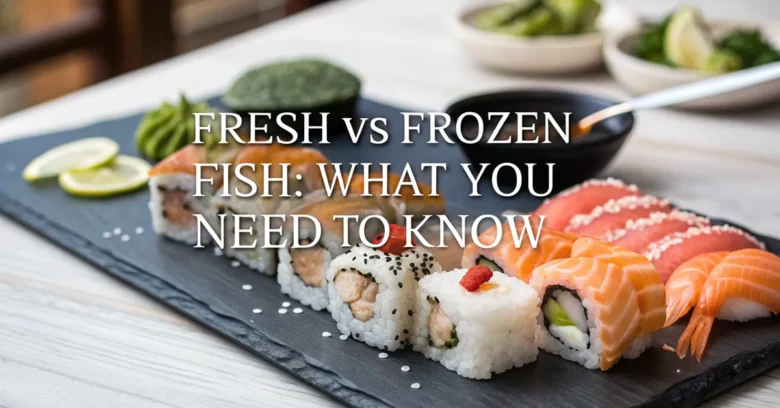Are you planning a sushi night? Then you might find yourself at the fish counter, staring at labels that read “fresh” and “frozen.” Does it matter which you pick? Absolutely! The choice between fresh fish and frozen fish is more than just a matter of preference; it’s about safety, quality, and taste.
Navigating the seafood aisle can be confusing, but with a bit of know-how, you can make the best choice for your needs. This article will cut through the myths and give you the facts about fresh fish versus frozen, so you can create sushi that’s both delicious and safe.
Fresh Fish vs. Frozen Fish: What You Need to Know
When it comes to sushi, the quality of your fish is paramount. For many home cooks, the terms “fresh” and “frozen” can be misleading. Let’s explore what each term really means, especially when it comes to fish intended for raw consumption.
Defining “Fresh” Fish
The term “fresh fish” conjures up images of fishermen hauling in their daily catch, destined for your plate within hours. However, the reality is often more complex. “Fresh fish” typically refers to fish that hasn’t been frozen, but that doesn’t necessarily mean it was swimming yesterday.
Here are some things to consider about “fresh fish”:
- Time Since Catch: Fish labeled “fresh” can be several days old, depending on the supply chain. From the moment it’s caught, fish starts to degrade.
- Storage Conditions: How the fish is stored matters a great deal. Even if it’s “fresh,” improper handling and storage can lead to bacterial growth and a decline in quality.
- Source and Handling: Knowing where your fish comes from and how it has been handled can give you a better indication of its true freshness.
The Truth About Frozen Fish
Many people assume that frozen fish is inferior to fresh. However, modern freezing technology has changed the game. When fish is flash-frozen shortly after being caught, it can actually preserve its quality and safety better than fish that is days old and labeled “fresh.”
Here’s what you should know about frozen fish:
- Flash Freezing: This process involves rapidly freezing the fish at very low temperatures, which minimizes ice crystal formation. Smaller ice crystals mean less damage to the fish’s cells, resulting in better texture and flavor upon thawing.
- Safety Benefits: Freezing can kill certain parasites that may be present in raw fish, making it a safer option for sushi. The FDA recommends freezing certain types of fish intended for raw consumption to -4°F (-20°C) for at least 7 days to kill parasites.
- Convenience and Availability: Frozen fish is often more readily available and can be stored for longer periods, making it a convenient option for home cooks.
The Safety Factor: Why Freezing Matters for Sushi
When making sushi at home, safety should be your top concern. Raw fish can harbor parasites and bacteria that can cause illness. Freezing is an effective way to mitigate these risks.
Parasite Prevention
Certain types of fish, such as salmon, tuna, and mackerel, are more likely to contain parasites. Freezing to the temperatures recommended by the FDA significantly reduces the risk of parasite infection.
While freezing doesn’t eliminate all risks, it provides a crucial layer of protection. Always ask your fishmonger if the fish you’re buying has been frozen to the appropriate temperature for parasite destruction.
Bacteria Control
While freezing doesn’t kill all bacteria, it does slow down their growth. Fresh fish that isn’t properly stored can develop high levels of bacteria, which can lead to food poisoning. Frozen fish, especially when thawed correctly, is less likely to harbor dangerous levels of bacteria.
Understanding Sushi-Grade Fish
You may have heard the term “sushi-grade” fish, but it’s not an officially regulated term. In general, it means that the fish has been handled in a way that minimizes the risk of contamination and is considered safe for raw consumption.
However, “sushi-grade” doesn’t guarantee that the fish is parasite-free. Always ask your fishmonger about their handling practices and whether the fish has been frozen.
Quality and Taste: Does Freezing Affect Flavor and Texture?
One of the biggest concerns about frozen fish is its potential impact on flavor and texture. While it’s true that improper freezing can degrade the quality of fish, modern techniques can actually preserve its taste and texture remarkably well.
The Impact of Ice Crystals
The formation of large ice crystals during freezing can damage the cells of the fish, leading to a mushy or dry texture upon thawing. Flash freezing minimizes this damage by creating smaller ice crystals.
Thawing Techniques
Proper thawing is just as important as proper freezing. Thawing fish slowly in the refrigerator is the best way to preserve its quality. Avoid thawing fish at room temperature, as this can promote bacterial growth.
Species Matters
Some types of fish hold up better to freezing than others. Fatty fish like salmon and tuna tend to retain their flavor and texture better than lean fish like cod or flounder.
Signs of Quality
When buying frozen fish, look for signs of quality:
- Clear Packaging: The fish should be clearly visible through the packaging, with no signs of freezer burn.
- Firm Texture: The fish should feel firm to the touch, not soft or mushy.
- Minimal Ice Crystals: There should be minimal ice crystals inside the packaging.
Making the Right Choice: Factors to Consider
Choosing between fresh and frozen fish for sushi depends on several factors, including availability, budget, and personal preferences. Here’s a breakdown to help you make the right choice:
Availability
If you live near the coast or have access to a reputable fish market with a steady supply of fresh fish, that may be a good option. However, if you live inland or don’t have reliable access to fresh seafood, frozen fish is a convenient and safe alternative.
Budget
Frozen fish is often more affordable than fresh fish, especially if you’re buying high-quality, sushi-grade fish. This can make it a more budget-friendly option for home cooks.
Personal Preferences
Ultimately, the choice between fresh and frozen fish comes down to personal preference. Some people prefer the taste and texture of fresh fish, while others find that frozen fish is just as good, especially when handled properly.
Questions to Ask Your Fishmonger
Before buying fish for sushi, ask your fishmonger these questions:
- Has this fish been frozen to -4°F (-20°C) for at least 7 days to kill parasites?
- Where did this fish come from?
- How was this fish handled and stored?
- When was this fish caught?
The answers to these questions will help you make an informed decision and ensure that you’re buying safe, high-quality fish.
Step-by-Step Guide to Thawing Frozen Fish for Sushi
Thawing frozen fish correctly is crucial for maintaining its quality and safety. Here’s a step-by-step guide:
- Plan Ahead: Thawing fish in the refrigerator takes time, so plan ahead. Allow at least 24 hours for every pound of fish.
- Keep it Cold: Place the frozen fish in its original packaging or in a sealed bag on a plate or tray in the refrigerator. This will prevent it from contaminating other foods.
- Monitor the Temperature: Ensure that your refrigerator is set to a temperature of 40°F (4°C) or below.
- Check for Doneness: The fish is thawed when it is pliable and no longer feels icy.
- Use Promptly: Once thawed, use the fish promptly, ideally within 24 hours. Do not refreeze thawed fish.
Making Sushi at Home: Tips and Techniques
Now that you know the ins and outs of fresh vs. frozen fish, here are some tips and techniques for making sushi at home:
Essential Equipment
- Sushi Rice: Use short-grain Japanese rice specifically labeled for sushi.
- Rice Cooker: A rice cooker makes it easy to cook perfect sushi rice every time.
- Sushi Rolling Mat: A bamboo rolling mat helps you shape sushi rolls.
- Sharp Knife: A sharp knife is essential for slicing sushi cleanly.
- Cutting Board: Use a clean cutting board dedicated to sushi preparation.
Making Sushi Rice
- Rinse the Rice: Rinse the sushi rice under cold water until the water runs clear.
- Cook the Rice: Cook the rice according to the rice cooker instructions or on the stovetop.
- Prepare the Sushi Vinegar: Mix rice vinegar, sugar, and salt in a small saucepan and heat until the sugar dissolves.
- Combine Rice and Vinegar: Gently fold the sushi vinegar into the cooked rice and let it cool.
Rolling Sushi
- Prepare Your Ingredients: Slice your fish into thin strips and prepare any other fillings, such as vegetables or avocado.
- Place Nori on the Mat: Place a sheet of nori (seaweed) on the sushi rolling mat.
- Spread the Rice: Spread a thin layer of sushi rice over the nori, leaving a small border at the top.
- Add the Fillings: Arrange the fish and other fillings in a line across the center of the rice.
- Roll the Sushi: Use the rolling mat to tightly roll the sushi, starting from the edge closest to you.
- Slice and Serve: Use a sharp knife to slice the sushi roll into bite-sized pieces. Serve with soy sauce, wasabi, and ginger.
Beyond the Basics: Exploring Fish Varieties for Sushi
While salmon and tuna are popular choices for sushi, there are many other types of fish to explore. Here are a few options:
- Yellowtail (Hamachi): A rich, buttery fish that is often served as sashimi or nigiri.
- Mackerel (Saba): A strong-flavored fish that is often marinated in vinegar.
- Eel (Unagi): A sweet and savory fish that is often grilled and glazed with a sauce.
- Snapper (Tai): A mild and delicate fish that is often served as nigiri.
The Environmental Impact: Sustainable Sushi Choices
As awareness of environmental issues grows, it’s important to make sustainable choices when buying fish for sushi. Here are a few tips:
- Choose Sustainable Species: Look for fish that are sustainably harvested or farmed.
- Support Responsible Fisheries: Buy fish from fisheries that are committed to sustainable practices.
- Avoid Overfished Species: Avoid buying fish that are known to be overfished.
- Check Seafood Watch: Consult the Monterey Bay Aquarium Seafood Watch guide for recommendations on sustainable seafood choices.
Is Frozen Fish the Secret to Safe Sushi?
When you want to make sushi at home, going with frozen fish is the smartest choice. But it’s not the only thing. Make sure that the frozen fish you get has been frozen the right way and you thaw it right. This way, you’re safe, you can get affordable fish and you can enjoy your sushi without a worry.



